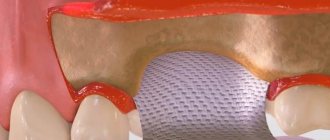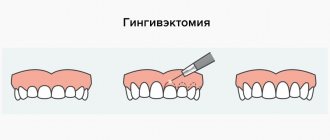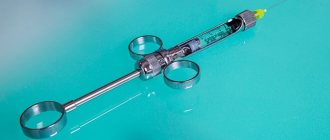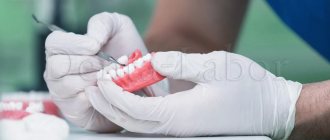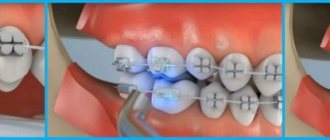Ceramic or metal-free crowns began to be used in dental prosthetics relatively recently. Compared to metal and metal-ceramic crowns, ceramic dentures are more aesthetically pleasing; for this reason, they are most often used to restore front teeth, which are clearly visible to others when smiling and talking. Aesthetics is not the only advantage of metal-free dental crowns; they have a number of other advantages that ensure their high demand among both patients and orthodontists.
In this article we will tell you in detail about ceramic (metal-free) dental crowns. After reading the material, you will learn in what clinical situations ceramic crowns are recommended for dental prosthetics, what features and unique advantages they have. We will look at the types of ceramic dental crowns, their manufacturing technologies, as well as prices for metal-free crowns in Moscow.
Design features of ceramic (metal-free) dental crowns
A ceramic crown is a prosthesis placed on a tooth or installed on an implant. Its peculiarity is that it is produced without the use of a metal base, which is used for the manufacture of metal-ceramic crowns. Modern metal-free dental crowns can be made from dental ceramics, glass ceramics, and zirconium dioxide.
Ceramics, glass ceramics and zirconium are materials that have the highest aesthetics. They have a translucency like natural tooth enamel, so metal-free dental crowns are almost impossible to distinguish from natural teeth. A wide range of colors and shades of materials allows you to get an ideal smile with straight and beautiful teeth as a result of prosthetics.
But in addition to beauty, metal-free dental crowns are completely reliable and functional products. Their installation allows you to qualitatively restore all the most important functions of the teeth and obtain the correct distribution of the chewing load.
Of course, the price for ceramic dental crowns will be higher than for prosthetics with metal and ceramic crowns. But the cost of ceramic prosthetics is well worth the benefits that can be obtained by choosing ceramic crowns.
Below we will analyze in detail all the benefits that a patient can receive by choosing ceramic crowns for prosthetics.
What is a dental crown
A crown is a type of dental prosthesis, non-removable, completely or partially covering the visible part of the tooth. Sometimes it is part of a larger prosthesis, such as a bridge. Crowns are distinguished:
- orthopedic. Replenish the missing part of the tooth crown. These include equatorial, three-quarter (for premolars), half-crowns (protect part of the vertical surface and the cutting edge);
- full clinical. Like a cap, they cover the entire stump of the tooth.
- stump, fenestrated, crowns with a pin are placed when more than 80% of tooth decay occurs, so they are often classified as pin structures.
To ensure that the crown does not interfere with the closure and active movement of the jaw, it is made according to the shape of the tooth, with a tight coverage of the neck without immersing more than 0.2 mm in the gum pocket. “Parts” for this type of fixed prosthetics are cast from metals, alloys, porcelain, and plastic. There are combined dentures, when a material different from the base is used for lining.
An inlay is first installed under the crown. Happens:
- straight (direct), made in the mouth, used when the tooth has 3 out of 4 walls left. Externally, it is a screw or pin that is inserted into the canal with a filling;
- indirect (indirect), an impression is made, and the inlay is cast from it in the laboratory.
The pin cult inlay is considered more reliable (and expensive); a ceramic inlay is placed under ceramic dentures.
Dental crown
The main advantages of ceramic dental crowns
What benefits can you get by choosing to put ceramic crowns on your teeth? This question is often asked by patients to orthodontists, and therefore below we will consider in detail all the advantages of metal-free dental crowns.
The main advantages of using ceramic crowns for dental prosthetics include:
- An ideal indicator of the compatibility of dental ceramics with natural tissues of the human body. Ceramic crowns do not lead to allergic reactions, their surface does not darken or change its attractive color under the influence of external factors, wearing them does not cause an unpleasant metallic taste in the mouth;
- Aesthetics of prostheses. If you decide to put ceramic crowns on your front teeth, you can be sure that strangers will not even notice that you have not your own teeth, but a prosthesis;
- The use of modern technologies allows the prosthetist to make ceramic crowns individually for the patient. The finished prosthesis will fit tightly to the core base, without gaps, and such high precision in the production of metal-free crowns ensures a long service life and eliminates the occurrence of inflammation and caries in the tooth under the crown;
- Metal-free crowns are not massive, are light in weight (compared to bulky and heavy metal prostheses), they do not create dangerous unwanted stress on adjacent healthy teeth and gums;
- Ceramic crowns have an absolutely smooth surface that does not stain from contact with food, does not accumulate plaque, and does not absorb odors.
With so many advantages, ceramic dental crowns also have certain disadvantages that are important to consider before you decide to place them on your front or chewing teeth.
Advantages and disadvantages of prostheses
Unlike metal and metal-ceramics, metal-free ceramics have a number of significant advantages. First of all, it has a long service life. As a rule, the service life of such structures is 10 years or more. Dental ceramics do not crumble, crack, stain, or change shape. If necessary, the shape of such dental crowns can be corrected during wear (remove chips, eliminate damage, restore).
Ceramic teeth are light, do not create discomfort when chewing, and do not place a functional load on the remains of natural units under dentures. Dental ceramics with zirconium oxide are absolutely safe for the human body (even with prolonged use) - inflammatory processes do not develop under dentures, and neighboring teeth are not erased at the boundaries with such products.
These structures do not oxidize and do not change the taste of food. Teeth made of metal-free ceramics are absolutely hypoallergenic. With proper care, the service life of porcelain and zirconium crowns can range from 5 to 10 years.
Other advantages of prostheses:
- minimal trauma to the supporting units (the products are thin and durable, and therefore do not require significant grinding of the bone base for installation);
- aesthetics – visually, ceramic dentures are practically no different from natural teeth, creating the effect of a natural smile (thanks to the “living” shine of the enamel and the “ability” of ceramics to transmit light rays).
- Ceramic crowns for the front teeth are easy to care for and do not cause irritation to the surrounding soft tissues.
The disadvantages of such designs include:
- fragility (in this respect they are significantly inferior to metal products);
- small selection of materials (porcelain and zirconium);
- chewing teeth can be covered exclusively with zirconium ceramic prostheses;
- high price;
- difficulty in repair (restoring, painting, removing chips on such a product is much more difficult and more expensive than when working with metal structures).
Some disadvantages of ceramic crowns that are important to consider before prosthetics
When planning to place ceramic crowns on your front or chewing teeth, it is important to take into account certain disadvantages of dentures made from this material:
- Some types of ceramics are quite fragile and cannot withstand the pressure that occurs when biting and chewing food. For example, porcelain crowns can crack and chip from a strong impact. If high strength is required from the crown for dental prosthetics, then it is better to initially opt for metal-free prostheses made of zirconium or pressed ceramics;
- Difficulty of restoration. If a ceramic crown is damaged, it is easier to replace it completely than to try to repair a broken denture.
Some people consider the disadvantages of ceramic crowns to be their high price. Of course, the price of ceramic crowns is much higher than that of metal and metal-ceramic prostheses. But only ceramic prosthetics allows you to achieve a truly high level of aesthetics, and if the crown is made correctly and accurately, and you take proper care of it, it will serve you no less than a metal prosthesis.
Why do modern dentists choose ceramics?
Today, there are four main materials in restorative dentistry: composite (essentially plastic), metal (various alloys, including noble metals), zirconium dioxide (metal oxide, very durable and bioinert) and ceramics.
The form of this article will not allow us to compare all these materials in detail, so it will be easier to talk about the advantages of ceramics:
- Aesthetics – wins over all of the above materials. A competent dental technician can make an artificial crown that is indistinguishable from a natural tooth in any light. This is not a common cliché - ceramics really are as close as possible in optical properties to tooth tissue;
- Strength - of course, metal and zirconium dioxide are stronger, but their strength significantly exceeds what is necessary for the oral cavity - you will be gnawing stones with new crowns. With all this, the safety margin of modern ceramic masses is absolutely sufficient for all types of food that you would be willing to chew with your teeth;
- Preservation of properties over time - ceramics do not change its structure in the oral cavity - its surface remains the same smooth even after 10 years of use. This is important not only for aesthetics - plaque, which causes gum and periodontal diseases, does not linger on the smooth surface.
- Natural abrasion - yes, I didn’t say anything wrong, the abrasibility of ceramics is a big plus. Over the years, any natural tooth, when chewed, undergoes a process of natural abrasion, and if it comes into contact with such durable materials as metal or zirconium dioxide, natural abrasion turns into pathological - the tooth wears out more than necessary. Upon contact with ceramics, abrasion occurs evenly and is divided in equal quantities between living and artificial ceramic teeth.
Which teeth can be replaced with ceramic crowns?
Metal-free crowns can restore any tooth in the row - both the front and chewing ones. You just need to choose the right type of material. For example, for the restoration of teeth in the smile area, you can choose porcelain, ceramics, and glass ceramics. Zirconium crowns are more suitable for the restoration of posterior teeth.
Why do prosthetists recommend using radically different materials for prosthetics of back and front teeth? It's simple: the front and chewing teeth perform different functions and experience different degrees of stress. The heaviest load when eating food is placed on the back teeth, therefore the crown for their restoration must be strong. Therefore, for prosthetics of chewing teeth, metal-free zirconium crowns are most often used; their strength level is not inferior to metal products. The average price of zirconium oxide crowns per chewing dental unit is twenty thousand rubles.
USEFUL TO KNOW: To fix metal-free crowns on the back (chewing) teeth, not glue, but cement is often used, which allows you to secure the prosthesis as firmly as possible on the stump base.
When replacing anterior teeth, the strength of the crowns is less important, since the incisors and canines are less subject to stress. Here the primary indicator will be aesthetics - after all, the crown on the front teeth should look natural and be invisible to others. Therefore, when prosthetizing the front teeth, ceramic, porcelain and glass-ceramic crowns are relevant. The price of the crown will depend on the type of material.
USEFUL TO KNOW: The aesthetics of prosthetic restoration of the front teeth with ceramic crowns will depend on the accuracy of the manufacture of the prosthesis and the correct choice of its color.
Photos before and after prosthetics, which we supplement our article, will help you evaluate what ceramic and zirconium crowns look like on your teeth.
Crowns made from “IPS E.max” –
IPS E.max materials are metal-free lithium disilicate ceramics intended for the manufacture of crowns and veneers. The E.max material is glass-ceramic, the light transmittance/transparency of which is almost identical to natural tooth enamel. Because of this, lithium disilicate crowns and veneers are sometimes completely indistinguishable from real teeth.
There are 2 main E.max materials for making crowns. Firstly, this is “E.max PRESS”, which is designed for the manufacture of crowns and veneers using injection molding at high temperature and pressure. Let's say right away that this material is the best if you want to make single crowns or veneers, or you need a 3-unit bridge on your front teeth.
Secondly, this is “E.max CAD”, intended for the manufacture of crowns and veneers using the milling method (CAD/CAM technology), so the same method is used here as in the manufacture of zirconium crowns. Compared to E.max PRESS, this material already has slightly less strength and is no longer suitable for the manufacture of bridges and thin veneers. Another disadvantage is that E.max CAD has a much smaller range of material shades, which limits the dental technician’s ability to ensure that the crown actually blends in color with the adjacent teeth.
Clinical case No. 8 (before and after photos) –
Take a look at the before and after photos posted above. In this case, the patient used E.max CAD ceramics, although E.max PRESS ceramics has a significantly larger range of material shades (which provides more opportunities to make the crown invisible against the background of neighboring teeth). But in this case, the patient had crowns made for 10 front teeth at once, and therefore the dental technician was not faced with the task of accurately imitating the color and transparency of the neighboring teeth.
From this we can conclude that if you need to make one or more crowns, it is better to choose E.max PRESS ceramics. If you are going to make crowns for all the front teeth (at least one jaw), then “E.max CAD” ceramics are also suitable.
For more information about the various options for manufacturing zirconium crowns and the rating of manufacturers of zirconium dioxide blocks, read the article: → Options for manufacturing E.max crowns, prices
Types of metal-free (ceramic) crowns for teeth
Having told you about the pros, cons, and possibilities of installing ceramic crowns on the front and back teeth, let's talk about the types of orthopedic products made from this material. There are three main types of metal-free dental crowns:
- All-ceramic. These dental crowns are made from dental porcelain and have a fairly affordable price. They have a high level of aesthetics, but are very unstable to mechanical loads. For this reason, all-ceramic crowns are installed during prosthetics only in the area of the front teeth;
- All-zirconia crowns. They are made from zirconium oxide and have increased strength, allowing them to be used for prosthetics of back teeth - molars, which take an active part in the process of chewing food;
- Crowns on a zirconium frame with ceramic veneer. Such combined crowns provide both strength and high aesthetics and therefore can be used for the restoration of both anterior and chewing teeth.
What type of ceramic crowns is best for your case? Only a doctor can answer this question accurately and in detail, after examining and studying all the features of the clinical case, as well as taking into account your wishes. If you need detailed advice on dental prosthetics with ceramic crowns, you can get it at any time convenient for you by visiting an orthopedic doctor’s office in our dental clinic in Moscow - “Firadent”.
How are crowns placed on front teeth?
The question of how to make and install a crown on a front tooth interests many dental visitors. This process is identical to the manufacture of dentures for the chewing area and involves performing several sequential steps:
- In the case of installing an orthopedic structure on a natural tooth, the dental canals are initially treated, followed by filling them and fixing the pin. This metal rod acts as a support and serves to more securely hold the prosthesis.
- After the filling is installed, the tooth is prepared to the required size and impressions are taken. After this, the process of producing the orthopedic structure in the laboratory begins, based on the existing plaster models.
- Fixation of the prosthesis on the front tooth. For this purpose, a special cement composition is used. If you cannot adapt to the installed crowns for a long time, it means that mistakes were made during work.
The Elident clinic employs highly qualified orthopedists who have solid experience in the field of prosthetic installation, regularly learn professional skills from Western colleagues and are focused on providing the highest level of services. This eliminates any discomfort after the prosthetic procedure. At the same time, artificial analogues fully correspond to natural ones in shade and transparency, and are not felt by patients as a foreign body.
When is it possible and when not to perform dental prosthetics with ceramic crowns?
The main indications for dental prosthetics with ceramic crowns will be as follows:
- More than 50% tooth decay;
- Absence of a tooth in any part of the dentition;
- The need to eliminate an aesthetic defect: a chipped tooth, unsightly enamel color;
- Tooth restoration after injury (provided the tooth root remains intact and healthy);
- An allergic reaction to metal alloys, excluding the use of metal dentures.
Dental prosthetics with ceramic crowns are not performed if the location of the pulp (nerve of the tooth) is too close, as well as with advanced periodontitis. Contraindications to the installation of metal-free crowns are excluded at the stage of diagnosis and treatment planning.
Indications for prosthetics by installing dental crowns
There are certain indications for installing a crown on a tooth, as for any other dental procedure. In what cases is prosthetics with dental crowns performed? It would be advisable to carry out the procedure in the following circumstances:
- Significant destruction of dental units by deep caries.
- Traumatic tooth destruction, in which the unit still has healthy roots.
- Aesthetic defects: noticeable discoloration of the enamel coating, chips.
Also, the installation of temporary crowns will be justified in case of periodontitis: the design will prevent further loosening of the teeth and, accordingly, will protect them from falling out. Indications for crown installation are determined during a diagnostic examination. Do you need to get a crown on your tooth? The orthopedists of our dentistry in Moscow - VENSTOM - will help you find the answer to this question! Come see a specialist at any time convenient for you. We are located next to the Baumanskaya metro station, you can walk to the clinic from the metro in just five minutes!
Firing technology
This technology for making ceramic dental crowns involves firing them on a fire-resistant model, which is made from special heat-resistant materials. Crowns produced using this technology have a number of advantages:
- Short production times and at the same time high accuracy rates of the finished crown;
- Various substances can be added to the ceramic sintered mass to obtain both improved strength characteristics and the desired color of the finished ceramic crown, which ideally matches the natural shade of the patient’s tooth enamel;
The advantages of ceramic crowns produced using firing technology include an affordable price.
How to care for ceramic crowns
Recommendations for caring for ceramic products are not too different from the rules of oral hygiene in general. It is enough to regularly brush your teeth, between teeth, and periodically visit the dentist. For care, you can use all hygiene products: paste, floss, irrigator, rinse. It is only important to remember that it is better to clean the crowns with a soft or even ultra-soft brush, so as not to injure the artificial enamel. You can use dental floss, but very carefully, without picking up the contact area between the crown and the tissues of the natural tooth, so that microcracks do not appear in this area.
It is advisable to give up the habit of gnawing nuts, seeds, and opening lids with your teeth.
CAD/CAM
The considered method of producing ceramic dental crowns involves the production of structures on a special milling machine. The model from which the tooth crown will be made is created using a special computer program and then transferred to a milling machine.
The manufacturing technology of a ceramic crown for dental prosthetics will affect its price. Therefore, when drawing up a prosthetic plan, the doctor, together with the patient, will decide on the method of production of the prosthesis.
What do natural teeth look like?
Innate color depends on:
- genetic factor;
- human habitat;
- skin color, race.
There is a common belief that black people have a white smile. This is a fallacy, an optical illusion. Their smiles appear brighter against dark skin backgrounds. If you compare the jaws of an African American and a Slav, the result is the same. This phenomenon is found in tanned people. If a person lies in the sun for at least an hour, this is enough to transform his smile.
The main stages of manufacturing ceramic crowns for dental prosthetics
The process of making ceramic crowns for dental prosthetics will consist of the following steps:
- Diagnostic stage. At this stage, the patient undergoes an examination by an orthopedic dentist, after which it is decided which crowns to put on the teeth and a treatment plan is drawn up.
- Preparation stage. Before placing a ceramic crown on a tooth, you need to properly prepare not only the tooth itself for prosthetics, but also the oral cavity as a whole. To do this, professional teeth cleaning is carried out, and dental diseases of the teeth and gums diagnosed during the examination are treated. The preparation stage also includes depulping the tooth and turning it, which makes it possible to obtain a stump base on which the doctor will place a ceramic crown.
- An impression is taken from the prepared teeth, from which a model of the future crown is made.
The production time for a ceramic crown on a tooth will depend on the technology. When the ceramic crown is ready, the patient is invited to the clinic to try it on and temporarily install it on the tooth. If these measures do not reveal any defects in the finished crown, the patient will not complain of discomfort when wearing the prosthesis - the crown is fixed to the tooth on a permanent basis.
Disadvantages of ceramic dentures
The main disadvantage is the rather high cost. It is associated with the price of the material itself, the need to use high-precision, expensive equipment and a high level of specialist training.
Another disadvantage is the rapid wear of antagonist teeth - over time, their enamel wears off due to constant friction with ceramics. However, this is not a specific feature of ceramics - any restoration materials are denser than the tissue of a living tooth, so the process of gradual grinding down of the enamel is completely normal.
The fragility of ceramic products and the inability to install them on chewing teeth is also considered a negative quality, although dentists have now been able to achieve compositions that provide the necessary strength even under increased load. But here it is still better not to risk it and return to the traditional indication - restoration of only the group of frontal teeth.
How do ceramic crowns stay on teeth?
How do ceramic crowns stay on teeth? This question is often asked by patients planning to put ceramic crowns on their teeth, and we will answer it in detail below.
To place a ceramic crown on a tooth and firmly fix it on it, the doctor will not sharpen the tooth much or install a pin under the root. He removes a small amount of tissue from the tooth so as to obtain enough space for placing the ceramic crown itself on the stump and its subsequent fixation with glue. As a result, the crown “sits” tightly on the tooth and there are no cracks or gaps left between the ceramic product and the natural tissues of the tooth.
The glue will firmly hold the ceramic crown in place and at the same time, the border between the prosthesis and the tooth will remain invisible. The invisibility of the connection between the ceramic crown and the tooth is of fundamental importance when carrying out prosthetics in the area of the anterior teeth.
If a ceramic crown is planned to be placed on a chewing tooth, strong dental cement is used to secure it firmly to the stump.
Metal-ceramic crowns
Metal-ceramic crowns. This type of prosthesis is a metal frame lined with ceramic mass and glaze on top. The more professional the technician, the more the crown is indistinguishable from a natural tooth. These crowns are strong, wear-resistant, have a long service life, and have been used by dentists for more than a hundred years.
Advantages of metal-ceramic crowns:
- Withstand very strong chewing loads without deformation of the frame;
- The service life of metal-ceramics reaches 10 years or more;
- They have an aesthetic appearance and are visually indistinguishable from natural teeth (cases of specific lighting are not considered);
- Relatively low price.
Disadvantages of metal ceramics:
- Before installing crowns, the teeth must be sharpened sufficiently (up to 2 mm on each side), and because... the anterior teeth have a smaller volume compared to the chewing teeth, the percentage of prepared tooth tissue is quite high;
- In many cases, tooth depulpation is required, since during grinding the pulp often dies, this is revealed already when the crowns are installed and the entire complex of work must be repeated;
- After some period of time after installation, blue discoloration may appear along the edges of the crowns - the blue edge of the gums. This problem arises in connection with the metal base of the structure;
- When replacing one or a pair of teeth under certain lighting, there will ALWAYS be a noticeable difference between the natural teeth and the crown.
How long can a ceramic tooth crown last?
Ceramic crowns are durable and wear-resistant - they can serve their owner for ten years or more. But at the same time, you need to properly care for the ceramic crown after prosthetics, maintain oral hygiene and periodically undergo examination by a dentist.
If you have all-ceramic crowns placed on your front teeth, you should refrain from biting and chewing hard foods. A ceramic crown may not be able to withstand such a load, and if it breaks, then it will have to be removed, restored and reinstalled.
Ceramic crowns do not require any special care after prosthetics - you can care for them just like your natural teeth.
Preparing to install dental crowns
Traditionally, crowns are placed on dead (pulpless) teeth, but sometimes there is a need to install a structure on living teeth. This has a positive effect on the final result of prosthetics, since living dental units are stronger and less susceptible to destruction processes, which ensures a long useful life of the crown. Usually, chewing teeth are not depulped during prosthetics. They have a significant area of the natural crown and the distance from the enamel layer to the pulp is greater, which eliminates burns to the natural tissues of the oral cavity during prosthetics.
How much does it cost to put a ceramic crown on a tooth?
The approximate price for a ceramic crown for dental prosthetics is about 20 thousand rubles. The indicated price includes the ceramic crown itself, as well as tooth preparation services that must be carried out in order to install the prosthesis. The price of the crown will consist of the following factors: the price of the material, technology for manufacturing the prosthesis, and the complexity of the clinical case.
But the total price of prosthetics with ceramic crowns may be higher than the indicated amount, because some additional procedures may be carried out during treatment: for example, sanitation of the oral cavity, tooth depulpation, treatment of dental canals. Therefore, it is better to find out the exact price of a crown directly in the clinic, from an orthopedic dentist. The doctor will conduct an examination and offer you the prosthetic option that suits you in terms of aesthetics, functionality and price.
USEFUL TO KNOW: in advertising offers from some clinics you can see a fairly low price for ceramic crowns - from seven thousand rubles. But believe me, such a price is not a reason for joy. Most likely, at this price, patients are offered either metal-ceramics, or it is simply the price of the crown itself, without treatment and preparation of the tooth, and in the end the cost of prosthetics will be 3-4 times higher. Therefore, do not be tempted by beautiful advertising and the opportunity to save money - always find out all the details about dental prosthetics in a specific clinic!
If you want to find out the exact price of prosthetics with ceramic crowns, call or come to an appointment with our specialists at the dental clinic in Moscow - “Firadent”. We do not promise our patients the lowest prices for prosthetics and installation of ceramic crowns, but we guarantee high quality and comfort of treatment!
Restoration of ceramic crowns
Despite the strength of modern ceramic dentures, the query “The ceramic has broken off from the crown, what should I do?” found on the Internet quite often. Typically a defect occurs for the following reasons:
- injury - blow or fall;
- defects in the work of a dental technician;
- malocclusion, bruxism;
- strong mechanical impact on the structure during chewing.
There are two possible solutions to the problem - replacement and restoration.
- Replacement of prosthesis. The crown is removed from the mouth, and the entire prosthetic process is repeated from the moment the impressions are taken until the new structure is attached.
- Restoration. The chip on the ceramic crown is polished to the optimal shape, and a light-curing composite material is placed into the cavity. After hardening, the specialist models the coating, forms bumps and fissures, and grinds uneven edges to the desired size.
The advantages of repair are short time and low cost; chipped ceramics on the crown can be restored in an hour in the dentist’s chair. However, even the use of the most modern materials does not provide the quality that is obtained when making a prosthesis “from scratch” in a dental laboratory. If the cause of the chip was carelessness when chewing hard food, after repair the denture will last for many years. Malocclusions and other pathologies of the dental system reduce the service life of the restored crown several times.
Cost of installing a crown on an implant
A ceramic crown can be placed not only on a tooth, but also on an implant. The price of such prosthetics will be more expensive, since it will include the cost of the implant, the operation for its implantation, and in some cases the price of preliminary osteoplasty. But the high cost in this case will be compensated by the reliability and durability of the result, its high aesthetics, and in addition, installing a crown on an implant does not require grinding down healthy teeth.
It is also impossible to announce the exact price of installing a ceramic crown on an implant right away and without taking into account a number of important factors. The price of the service will depend on the type of implant, the complexity of the clinical case, the technology of implantation, the material and manufacturing technology of the ceramic crown. Therefore, the exact price for installing a ceramic crown on a turnkey implant can only be determined after visiting a dental clinic.
You can always get detailed and honest answers to any questions about prosthetics and dental implantation by contacting our dentistry in Moscow - Firadent.
Prices for installing crowns at the CLINIC OF DOCTOR ZHURAVLEV
| Solid crown | PC. | 3600 rub. |
| Metal-ceramic crown | PC. | 6000 rub. |
| Metal-ceramic crown on an implant | PC. | 15,000 rub. |
| Zirconium oxide crown for implant | PC. | 16,000 rub. |
| Crown based on zirconium oxide | PC. | 13000 rub. |
| Endocrown | PC. | 12000 rub. |
| Pressed ceramic crown | PC. | 14,000 rub. |

